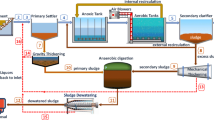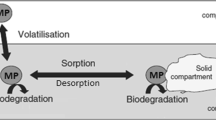Abstract
The presence of micropollutants in the environment has triggered research on quantifying and predicting their fate in wastewater treatment plants (WWTPs). Since the removal of micropollutants is highly related to conventional pollutant removal and affected by hydraulics, aeration, biomass composition and solids concentration, the fate of these conventional pollutants and characteristics must be well predicted before tackling models to predict the fate of micropollutants. In light of this, the current paper presents the dynamic modelling of conventional pollutants undergoing activated sludge treatment using a limited set of additional daily composite data besides the routine data collected at a WWTP over one year. Results showed that as a basis for modelling, the removal of micropollutants, the Bürger–Diehl settler model was found to capture the actual effluent total suspended solids (TSS) concentrations more efficiently than the Takács model by explicitly modelling the overflow boundary. Results also demonstrated that particular attention must be given to characterizing incoming TSS to obtain a representative solids balance in the presence of a chemically enhanced primary treatment, which is key to predict the fate of micropollutants.





Similar content being viewed by others
References
Mulder A, Coen F, Vanderhaegen B, Boonen I, Vanrolleghem PA, Van Meenen P (1997) Advanced wastewater treatment: nutrient removal and anaerobic processes. Improved design and control of industrial and municipal nutrient removal plants using dynamic models. Water Sci Technol 35(10):53–61. doi:10.1016/S0273-1223(97)00217-5
Demey D, Vanderhaegen B, Vanhooren H, Liessens J, Van Eyck L, Hopkins L, Vanrolleghem PA (2001) Validation and implementation of model based control strategies at an industrial wastewater treatment plant. Water Sci Technol 44(2–3):145–153
Printemps C, Baudin A, Dormoy T, Zug M, Vanrolleghem PA (2004) Optimisation of a large WWTP thanks to mathematical modelling. Water Sci Technol 50(7):113–122
Weijers SR, De Jonge J, Van Zanten O, Benedetti L, Langeveld J, Menkveld HW, Van Nieuwenhuijzen AF (2012) Cost effective and integrated optimization of the urban wastewater system Eindhove. Water Pract Technol. doi:10.2166/wpt.2012.036
Coen F, Vanderhaegen B, Boonen I, Vanrolleghem PA, Van Eyck L, Van Meenen P (1996) Nitrogen removal upgrade of a wastewater treatment plant within existing reactor volumes: a simulation supported scenario analysis. Water Sci Technol 34(3):339–346. doi:10.1016/0273-1223(96)00591-4
Guo L, Vanrolleghem PA (2014) Calibration and validation of an activated sludge model for greenhouse gases No. 1 (ASMG1): prediction of temperature-dependent N2O emission dynamics. Bioprocess Biosyst Eng 37(2):151–163. doi:10.1007/s00449-013-0978-3
Henze M, Gujer W, Mino T, Matsuo T, Wentzel MC, Marais GVR, Van Loosdrecht MCM (1999) Activated sludge model No. 2D, ASM2D. Water Sci Technol 39(1):165–182. doi:10.1016/S0273-1223(98)00829-4
Smith M, Dudley J (1998) Dynamic process modelling of activated-sludge plants. J Chart Inst Water Environ Manag 12(5):346–356. doi:10.1111/j.1747-6593.1998.tb00196.x
Takács I, Patry GG, Nolasco D (1991) A dynamic model of the clarification-thickening process. Water Res 25(10):1263–1271. doi:10.1016/0043-1354(91)90066-Y
Bürger R, Diehl S, Nopens I (2011) A consistent modelling methodology for secondary settling tanks in wastewater treatment. Water Res 45(6):2247–2260. doi:10.1016/j.watres.2011.01.020
Bürger R, Diehl S, Farås S, Nopens I (2012) On reliable and unreliable numerical methods for the simulation of secondary settling tanks in wastewater treatment. Comput Chem Eng 41:93–105. doi:10.1016/j.compchemeng.2012.02.016
Torfs E, Maere T, Bürger R, Diehl S, Nopens I (2015) Impact on sludge inventory and control strategies using the Benchmark Simulation Model No. 1 with the Bürger–Diehl settler model. Water Sci Technol 71(10):1524–1535. doi:10.2166/wst.2015.122
Rieger L, Gillot S, Langergraber G, Ohtsuki T, Shaw A, Takacs I, Winkler S (2013) Guidelines for using activated sludge models. IWA Publishing, London
Clouzot L, Choubert J-M, Cloutier F, Goel R, Love NG, Melcer H, Ort C, Patureau D, Plósz BG, Pomiès M, Vanrolleghem PA (2013) Perspectives on modelling micropollutants in wastewater treatment plants. Water Sci Technol 68(2):448–461. doi:10.2166/wst.2013.272
Plósz BG, Langford KH, Thomas KV (2012) An activated sludge modeling framework for xenobiotic trace chemicals (ASM-X): assessment of diclofenac and carbamazepine. Biotechnol Bioeng 109(11):2757–2769. doi:10.1002/bit.24553
Urase T, Kikuta T (2005) Separate estimation of adsorption and degradation of pharmaceutical substances and estrogens in the activated sludge process. Water Res 39(7):1289–1300. doi:10.1016/j.watres.2005.01.015
Dionisi D, Bertin L, Bornoroni L, Capodicasa S, Papini MP, Fava F (2006) Removal of organic xenobiotics in activated sludges under aerobic conditions and anaerobic digestion of the adsorbed species. J Chem Technol Biotechnol 81(9):1496–1505. doi:10.1002/jctb.1561
Lindblom E, Press-Kristensen K, Vanrolleghem PA, Mikkelsen PS, Henze M (2009) Dynamic experiments with high bisphenol—a concentrations modelled with an ASM model extended to include a separate XOC degrading microorganism. Water Res 43(13):3169–3176. doi:10.1016/j.watres.2009.04.030
Vezzaro L, Benedetti L, Gevaert V, De Keyser W, Verdonck F, De Baets B, Nopens I, Cloutier F, Vanrolleghem PA, Mikkelsen PS (2014) A model library for dynamic transport and fate of micropollutants in integrated urban wastewater and stormwater systems. Environ Model Softw 53:98–111. doi:10.1016/j.envsoft.2013.11.010
Rogers HR (1996) Sources, behaviour and fate of organic contaminants during sewage treatment and in sewage sludges. Sci Total Environ 185(1–3):3–26. doi:10.1016/0048-9697(96)05039-5
Kreuzinger N, Clara M, Strenn B, Kroiss H (2004) Relevance of the sludge retention time (SRT) as design criteria for wastewater treatment plants for the removal of endocrine disruptors and pharmaceuticals from wastewater. Water Sci Technol 50(5):149–156
Suarez S, Lema JM, Omil F (2010) Removal of pharmaceutical and personal care products (PPCPs) under nitrifying and denitrifying conditions. Water Res 44(10):3214–3224. doi:10.1016/j.watres.2010.02.040
Rice EW, Baird RB, Eaton AD, Clesceri LS (2012) Standard methods for the examination of water and wastewater, 22nd edn. APHA/AWWA/WEF, Washington, DC
Vanrolleghem PA, Nopens I (2014) Wastewater Treatment. In: Price RK, Vojinovic Z (eds) Urban hydroinformatics: data, models, and decision support for integrated urban water management. IWA Publishing, London, pp 371–421
Baalbaki Z, Sultana T, Maere T, Vanrolleghem PA, Metcalfe CD, Yargeau V (2016) Fate and mass balance of contaminants of emerging concern during wastewater treatment determined using the fractionated approach. Sci Total Environ 573:1145–1158. doi:10.1016/j.scitotenv.2016.08.073
STOWA (1996) Methods for wastewater characterisation, inventory and guidelines (in Dutch), STOWA report 97–23. Hageman Fulfilment, Zwijndrecht
Roeleveld PJ, Van Loosdrecht MCM (2002) Experience with guidelines for wastewater characterization in The Netherlands. Water Sci Technol 45(6):77–87
Melcer H, Dold PL, Jone RM, Bye CM, Takács I, Stensel HD, Wilson AW, Sun P, Bury S (2003) Methods for wastewater characterization in activated sludge modelling. Water Environment Research Foundation et IWA Publishing, Alexandria
Rousseau D, Verdonck F, Moerma O, Carrette R, Thoeye C, Meirlaen J, Vanrolleghem PA (2001) Development of a risk assessment based technique for design/retrofitting of WWTPs. Water Sci Technol 43(7):287–294
Henze M, Gujer W, Mino T, Van Loosdrecht MCM (2000) Activated sludge models ASM1, ASM2, ASM2d and ASM3. IWA Publishing, London
Copp JB (2002) The COST simulation benchmark—description and simulator manual. European Cooperation in the Field of Scientific and Technical Research, Luxembourg
Office of Water Programs (1980) Operation of wastewater treatment plants, Volume I, vol 1, 4th edn. California State University, Sacramento Foundation, California
Tik S, Vanrolleghem PA (2012) Gestion des eaux usées en temps de pluie—De l’alun en périodes critiques à la Ville de Québec (in French). Vecteur Environn:32–33
Balmat JL (1957) Biochemical oxidation of various particulate fractions of sewage. Sew Ind Wastes 29(7):757–761
Heukelekian H, Balmat JL (1959) Chemical composition of the particulate fractions of domestic sewage. Sew Ind Wastes 31(4):413–423
Ødegaard H (1992) Norwegian experiences with chemical treatment of raw wastewater. Water Sci Technol 25(12):255
Ødegaard H (2005) Combining CEPT and biofilm systems. In: IWA specialized conference on nutrient management in wastewater treatment processes and recycle streams, Krakow, 19–21 September 2005, pp 257–269
Acknowledgements
The authors thank the staff at the Guelph WWTP for their help in providing the data. We gratefully acknowledge the McGill Engineering Doctoral Award for supporting Zeina Baalbaki. Funding for this study was provided by a research Grant to Viviane Yargeau (PI) and colleagues (Chris Metcalfe and Peter Vanrolleghem) from the Natural Sciences and Engineering Research Council (NSERC) of Canada through the Strategic Grants Program (430646-2012). Peter Vanrolleghem holds the Canada Research Chair on Water Quality Modelling.
Author information
Authors and Affiliations
Corresponding author
Electronic supplementary material
Below is the link to the electronic supplementary material.
Rights and permissions
About this article
Cite this article
Baalbaki, Z., Torfs, E., Maere, T. et al. Dynamic modelling of solids in a full-scale activated sludge plant preceded by CEPT as a preliminary step for micropollutant removal modelling. Bioprocess Biosyst Eng 40, 499–510 (2017). https://doi.org/10.1007/s00449-016-1715-5
Received:
Accepted:
Published:
Issue Date:
DOI: https://doi.org/10.1007/s00449-016-1715-5




